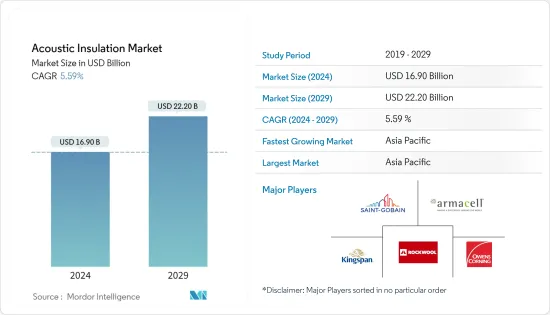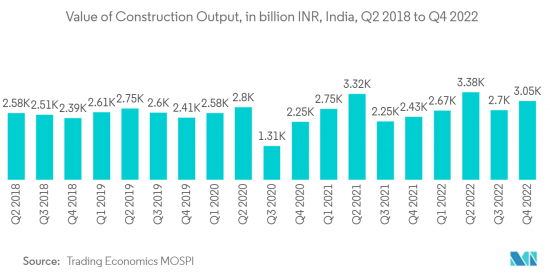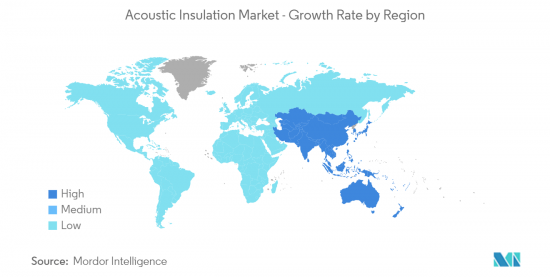 |
市场调查报告书
商品编码
1429246
隔音隔热材料:市场占有率分析、产业趋势与统计、成长预测(2024-2029)Acoustic Insulation - Market Share Analysis, Industry Trends & Statistics, Growth Forecasts (2024 - 2029) |
||||||
※ 本网页内容可能与最新版本有所差异。详细情况请与我们联繫。
隔音市场规模预计到 2024 年为 169 亿美元,预计到 2029 年将达到 222 亿美元,在预测期内(2024-2029 年)复合年增长率为 5.59%。

COVID-19的爆发对隔音材料行业造成了打击。全球封锁和严格的政府法规迫使大多数生产基地关闭,给它们带来了毁灭性的打击。儘管如此,业务自 2021 年以来已经復苏,预计未来几年将大幅成长。
主要亮点
- 短期内,政府对噪音污染控制的法规和住宅应用的快速采用是推动市场的主要因素。新兴国家不断增长的需求也将支持市场成长。
- 相反,原材料价格的波动和已开发国家需求的停滞预计将严重阻碍所研究市场的成长。
- 对美观外观和防火隔音性能的需求可能很快就会成为一个机会。
- 亚太地区主导全球隔音材料市场,预计在预测期内将大幅成长。
隔音材料市场趋势
商业建筑需求增加
- 商业建筑包括办公室、零售商店、电影院和其他休閒设施,隔热材料广泛应用于墙壁、地板、天花板、污水管、机房等。
- 商业建筑有一定的指导方针来避免外部噪音侵入、内部噪音和建筑服务噪音。然而,建筑物所需的隔热材料类型取决于其结构和需求。亚太地区、中东和非洲的商业建筑正在显着成长。
- 亚太、中东和非洲国家正在进行大量的国内和国际投资,用于建立工业单位、医院、商场、剧院、旅馆业和资讯科技部门。例如,印度政府已核准针对 16 家关键原料 (KSM)/医药中间体和活性药物成分 (API) 工厂的 PLI 计划。这16家工厂的建设将需要总合投资34.87亿印度卢比(4,701万美元)。这些工厂的商业开发预计将于 2023 年 4 月开始。因此,印度商业和工业单位不断增加的投资预计将创造对隔音材料的巨大需求。
- 由于印度、中国和印尼等国家的健康经济表现,以及中东国家努力发展旅游业和其他非石油产业,亚太地区已成为对外国公司有吸引力的市场。这些地区正在推动商业建设活动。例如,在沙乌地阿拉伯,根据“2030 年愿景”,计划到 2030 年在沙乌地阿拉伯各地开设 80 家新酒店,拥有 11,000 多间豪华客房。因此,饭店建筑投资预计将增加,隔音材料市场需求可期。
- 预计印度仍将是亚太地区二十国集团中成长最快的经济体。 IBEF预计,未来15年印度将需要在城市基础设施上投资8,400亿美元,以满足其快速成长的人口的需求。只有註重建筑物、桥樑、港口和机场的长期维护和强度,这种投资才是合理且永续的。
- 此外,印度民航国务部长宣布,印度政府还计划根据区域互联互通计划(RCS)-Ude Desh ka Aam Nagrik(UDAN)基础设施计划,到2024年建设100个机场。
- 此外,沙乌地阿拉伯正在进行许多商业计划,这可能会导致商业建筑的增加。例如,沙乌地阿拉伯宣布了价值5000亿美元的未来特大城市Neom计划,这是红海计划的第一阶段。其中包括分布在五个岛屿和两个内陆度假村、Qiddiya 娱乐城、超豪华健康旅游目的地Amaara 以及让·努维尔(Jean Nouvel) 位于埃尔奥拉(AlUla) 的Shara'an 度假村,拥有3,000间客房,包括14 间豪华和超豪华酒店。
- 因此,所有此类商业建筑投资和计划都在推动这些国家的建设活动并增加对隔音的需求。

中国主导亚太地区需求
- 由于投资和建设活动的增加,中国在亚太地区隔音材料市场占有率最大。近年来,中国一直是全球基础设施主要投资国之一,也是最大贡献国。例如,根据国家统计局(NBS)的数据,2022年中国建筑业产值将达到27.63兆元人民币(41.0858亿美元),比2021年增加6.6%。
- 中国是亚太地区GDP第一的经济大国。该国的成长仍然很高。但随着人口老化和经济从投资转向消费、从製造业转向服务业、从外需转向内需的再平衡,成长逐渐下降。
- 汽车隔音材料是汽车的重要组成部分。降低汽车内各种运动部件所产生的噪音。过多的噪音会降低驾驶人和乘客的舒适度,导致疲劳和压力增加。汽车仍然是该国最大的行业,并在不久的将来显示出积极的迹象。例如,根据国际汽车製造组织(OICA)的预测,2022年国内汽车产量将达到27,020,615辆,比2021年成长3%。因此,该国汽车生产的这种积极情况预计将导致对隔音材料的需求增加。
- 此外,中国预计在未来三年内超过美国,成为全球最大的航空旅行市场。儘管如此,该国的航空需求仍在呈指数级增长。例如,法国对中国进行国事访问期间,空中巴士公司与中国航空业合作伙伴签署了新的合作协议。空中巴士公司表示,未来20年,中国的航空运输量预计将以每年5.3%的速度成长,显着高于3.6%的全球平均水准。 2023年至2041年间,客机和货机的需求将达到8,420架,占全球总需求的20%以上,未来20年需要约39,500架新飞机。这是因为飞机吞吐量的增加将进一步促进隔音材料市场的开拓和成长。
- 此外,印度和日本等国家也为研究市场的成长做出了贡献。预计在预测期内,隔音隔热材料的需求将进一步增加。

隔音行业概况
隔热材料市场具有综合性。该市场的主要企业(排名不分先后)包括 Kingspan Group、Owens Corning、Saint-Gobain、Rockwool A/S 和 Armacell。
其他福利:
- Excel 格式的市场预测 (ME) 表
- 3 个月的分析师支持
目录
第一章简介
- 调查先决条件
- 调查范围
第二章调查方法
第三章执行摘要
第四章市场动态
- 促进因素
- 控制噪音污染的政府法规和住宅应用的快速采用
- 新兴国家的需求增加
- 其他司机
- 抑制因素
- 已开发国家需求停滞
- 原物料价格波动
- 其他阻碍因素
- 产业价值链分析
- 波特五力分析
- 供应商的议价能力
- 买方议价能力
- 新进入者的威胁
- 替代品的威胁
- 竞争程度
第五章市场区隔(以金额为准的市场规模)
- 类型
- 矿棉
- 玻璃棉
- 聚合物泡沫
- 天然材质
- 最终用户产业
- 住宅
- 商业建筑
- 运输
- 工业
- 地区
- 亚太地区
- 中国
- 印度
- 日本
- 韩国
- 其他亚太地区
- 北美洲
- 美国
- 加拿大
- 墨西哥
- 欧洲
- 德国
- 英国
- 义大利
- 法国
- 欧洲其他地区
- 南美洲
- 巴西
- 阿根廷
- 南美洲其他地区
- 中东/非洲
- 沙乌地阿拉伯
- 南非
- 其他中东/非洲
- 亚太地区
第六章 竞争形势
- 併购、合资、联盟、协议
- 市场占有率分析(%)**/排名分析
- 主要企业策略
- 公司简介
- 3M
- Armacell
- BASF SE
- Cabot Corporation
- Cellecta
- CSR Limited
- Dow
- Dynamic composite technologies
- Fletcher Insulation
- Insultech, LLC
- Johns Manville
- Kingspan Group
- Knauf Insulation
- L'ISOLANTE K-FLEX SpA
- Owens Corning
- Recticel Insulation
- ROCKWOOL A/S
- Saint-Gobain
- Siderise
- Trelleborg
- Xella(Etex Group)
第七章 市场机会及未来趋势
- 隔音材料的美观与防火要求
- 其他机会
The Acoustic Insulation Market size is estimated at USD 16.90 billion in 2024, and is expected to reach USD 22.20 billion by 2029, growing at a CAGR of 5.59% during the forecast period (2024-2029).

The COVID-19 epidemic harmed the acoustic insulation sector. Global lockdowns and severe rules enforced by governments resulted in a catastrophic setback as most production hubs were shut down. Nonetheless, the business is recovering since 2021 and is expected to rise significantly in the coming years.
Key Highlights
- Over the short term, government regulations for controlling noise pollution and a surge in the adoption of residential applications are the major factors driving the market studied. Also, a rise in demand from emerging economies boosts market growth.
- Conversely, fluctuating raw material prices and stagnant demand from developed countries are expected to significantly hinder the studied market's growth.
- Demand for aesthetic prospects and fire-resistant acoustic insulation properties will likely be an opportunity shortly.
- Asia-Pacific is dominating the global acoustic insulation market and is expected to grow significantly during the forecast period.
Acoustic Insulation Market Trends
Rising Demand from the Commercial Construction
- The commercial buildings include offices, retail, cinema, and other leisure outlets used for conducting operations of the enterprises where acoustic insulation materials find extensive application in walls, floors, ceilings, waste-water pipes, plant rooms, etc.
- In commercial buildings, there are certain guidelines to avoid external noise intrusion, internal noise, and noise from building services. However, the type of insulation required in the building varies according to its structure and need. Commercial construction is growing noticeably in Asia-Pacific, the Middle East, and Africa.
- Asia-Pacific, Middle East, and African countries are experiencing huge domestic and foreign investments for setting up industrial units, hospitals, malls, theaters, the hospitality industry, and the IT sector. For instance, India's government approved a PLI scheme for 16 plants for key starting materials (KSMs)/drug intermediates and active pharmaceutical ingredients (APIs). Establishing these 16 plants would result in a total investment of INR 348.70 crore (USD 47.01 million). The commercial development of these plants is expected to begin by April 2023. Therefore, increasing investments from commercial and industrial units in India are expected to create significant demand for acoustic insulation materials.
- Asia-Pacific is an attractive market for foreign companies due to the healthy economic performance of the countries like India, China, Indonesia, etc., and efforts made by the Middle Eastern countries to develop tourism and other non-oil sectors. They are driving commercial construction activities in these regions. For instance, in Saudi Arabia, under Vision 2030, 80 new hotels with more than 11,000 luxurious rooms are expected to open across Saudi Arabia by 2030. Therefore, increasing investments in the construction of hotels is expected to create demand for the acoustic insulation market.
- India is anticipated to remain the fastest-growing G20 economy in the Asia-Pacific region. According to IBEF, it is estimated that India needs to invest USD 840 billion over the next 15 years into urban infrastructure to meet the needs of its fast-growing population. This investment will only be rational and sustainable if we additionally focus on the long-term maintenance and strength of our buildings, bridges, ports, and airports.
- Moreover, in India, the Minister of State, Civil Aviation, announced that under the regional connectivity scheme (RCS)-Ude Desh ka Aam Nagrik (UDAN) infrastructure scheme, the Indian government also planned to construct 100 airports by 2024, owing to increasing demand for air commute.
- Furthermore, Saudi Arabia is working on many commercial projects, likely leading to more commercial buildings. For instance, the kingdom announced the USD 500 billion futuristic mega-city "Neom" project, the Red Sea Project - Phase 1, which is expected to be completed by 2025. It includes 14 luxury and hyper-luxury hotels with 3,000 rooms spread across five islands and two inland resorts, Qiddiya Entertainment City, Amaala - the uber-luxury wellness tourism destination, and Jean Nouvel's Sharaan resort in Al-Ula.
- Hence, all such commercial construction investments and projects are driving construction activities in these countries, increasing the demand for acoustic insulation.

China to Dominate the Demand in the Asia-Pacific Region
- China holds the largest Asia-Pacific market share for acoustic insulation due to rising investments and construction activity. China is the biggest contributor, as it is one of the leading investors in infrastructure worldwide over the past few years. For instance, according to the National Bureau of Statistics (NBS) of China, in 2022, the output value of construction works in China amounted to CNY 27.63 trillion (USD 4108.58 billion), an increase of 6.6% compared with 2021.
- China is the largest economy in the Asia-Pacific region in terms of GDP. The growth in the country remains high. However, it is gradually diminishing as the population ages, and the economy is rebalancing from investment to consumption, manufacturing to services, and external to internal demand.
- Automotive acoustic insulation is a vital part of the vehicle. It reduces the noise produced by various moving parts in the vehicle. The excess noise reduces the comfort level of both drivers and passengers, resulting in increased fatigue and stress. Automotive remains the largest sector in the country and reflects positive signs for the near future. For instance, according to Organisation Internationale des Constructeurs d'Automobiles (OICA), in 2022, automobile production in the country amounted to 2,70,20,615 units, which shows an increase of 3% compared with 2021. Therefore, such a positive scenario in the production of automobiles in the country is expected to create an upside demand for acoustic insulation materials.
- Furthermore, China will overtake the United States as the world's biggest air travel market within the next three years. Still, the country's appetite for aviation continues to grow exponentially. For instance, during a French state visit to China, Airbus signed new cooperation agreements with China's Aviation industry partners. According to Airbus, over the next 20 years, China's air traffic is forecast to grow at 5.3% annually, significantly faster than the world average of 3.6%. It will lead to a demand for 8,420 passenger and freighter aircraft between 2023 and 2041, representing more than 20% of the world's total demand for around 39,500 new aircraft in the next 20 years. It is due to the rising aircraft fleet throughput further augmenting the development and growth of the acoustic insulation market.
- Furthermore, countries such as India and Japan contribute to the studied market growth. It is expected to further drive the demand for acoustic insulation over the forecast period.

Acoustic Insulation Industry Overview
The acoustic insulation market is consolidated in nature. The major players in this market (not in any particular order) include Kingspan Group, Owens Corning, Saint-Gobain, Rockwool A/S, and Armacell.
Additional Benefits:
- The market estimate (ME) sheet in Excel format
- 3 months of analyst support
TABLE OF CONTENTS
1 INTRODUCTION
- 1.1 Study Assumptions
- 1.2 Scope of the Study
2 RESEARCH METHODOLOGY
3 EXECUTIVE SUMMARY
4 MARKET DYNAMICS
- 4.1 Drivers
- 4.1.1 Government Regulations for Controlling Noise Pollution and Surge in Adoption in Residential Application
- 4.1.2 Rise in Demand from Emerging Economies
- 4.1.3 Other Drivers
- 4.2 Restraints
- 4.2.1 Stagnant Demand from the Developed Countries
- 4.2.2 Fluctuating Raw Material Prices
- 4.2.3 Other Restraints
- 4.3 Industry Value Chain Analysis
- 4.4 Porter's Five Forces Analysis
- 4.4.1 Bargaining Power of Suppliers
- 4.4.2 Bargaining Power of Buyers
- 4.4.3 Threat of New Entrants
- 4.4.4 Threat of Substitute Products and Services
- 4.4.5 Degree of Competition
5 MARKET SEGMENTATION (Market Size in Value)
- 5.1 Type
- 5.1.1 Mineral Wool
- 5.1.2 Glass Wool
- 5.1.3 Polymeric Foams
- 5.1.4 Natural
- 5.2 End-user Industry
- 5.2.1 Residential Construction
- 5.2.2 Commercial Construction
- 5.2.3 Transportation
- 5.2.4 Industrial
- 5.3 Geography
- 5.3.1 Asia-Pacific
- 5.3.1.1 China
- 5.3.1.2 India
- 5.3.1.3 Japan
- 5.3.1.4 South Korea
- 5.3.1.5 Rest of Asia-Pacific
- 5.3.2 North America
- 5.3.2.1 United States
- 5.3.2.2 Canada
- 5.3.2.3 Mexico
- 5.3.3 Europe
- 5.3.3.1 Germany
- 5.3.3.2 United Kingdom
- 5.3.3.3 Italy
- 5.3.3.4 France
- 5.3.3.5 Rest of Europe
- 5.3.4 South America
- 5.3.4.1 Brazil
- 5.3.4.2 Argentina
- 5.3.4.3 Rest of South America
- 5.3.5 Middle-East and Africa
- 5.3.5.1 Saudi Arabia
- 5.3.5.2 South Africa
- 5.3.5.3 Rest of Middle-East and Africa
- 5.3.1 Asia-Pacific
6 COMPETITIVE LANDSCAPE
- 6.1 Mergers and Acquisitions, Joint Ventures, Collaborations, and Agreements
- 6.2 Market Share Analysis (%)**/Ranking Analysis
- 6.3 Strategies Adopted by Leading Players
- 6.4 Company Profiles
- 6.4.1 3M
- 6.4.2 Armacell
- 6.4.3 BASF SE
- 6.4.4 Cabot Corporation
- 6.4.5 Cellecta
- 6.4.6 CSR Limited
- 6.4.7 Dow
- 6.4.8 Dynamic composite technologies
- 6.4.9 Fletcher Insulation
- 6.4.10 Insultech, LLC
- 6.4.11 Johns Manville
- 6.4.12 Kingspan Group
- 6.4.13 Knauf Insulation
- 6.4.14 L'ISOLANTE K-FLEX S.p.A.
- 6.4.15 Owens Corning
- 6.4.16 Recticel Insulation
- 6.4.17 ROCKWOOL A/S
- 6.4.18 Saint-Gobain
- 6.4.19 Siderise
- 6.4.20 Trelleborg
- 6.4.21 Xella (Etex Group)
7 MARKET OPPORTUNITIES AND FUTURE TRENDS
- 7.1 Demand for Aesthetic Prospects and Fire-resistant Properties of Acoustic Insulation
- 7.2 Other Opportunities













